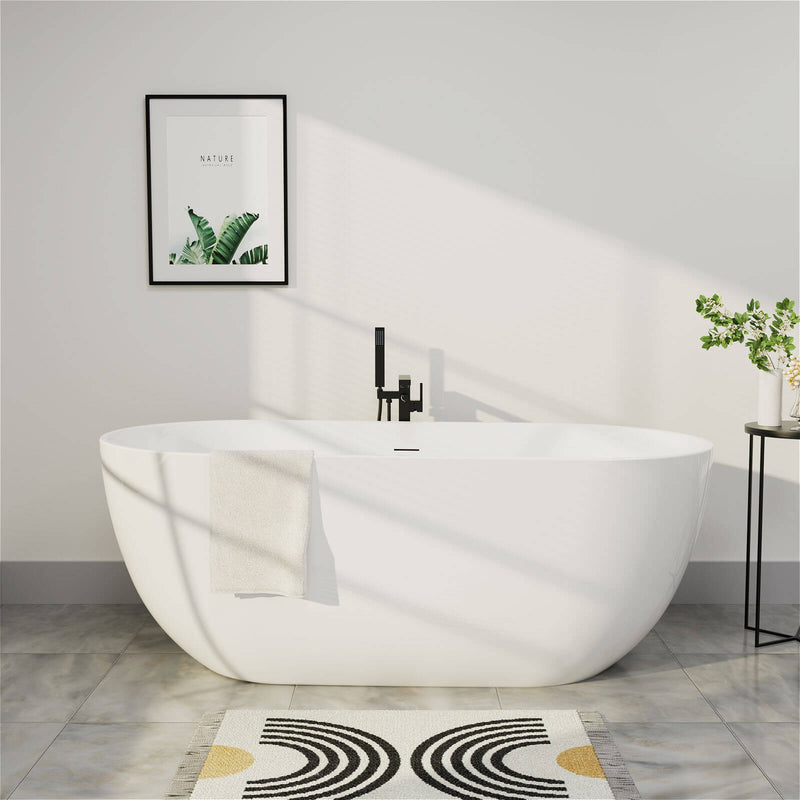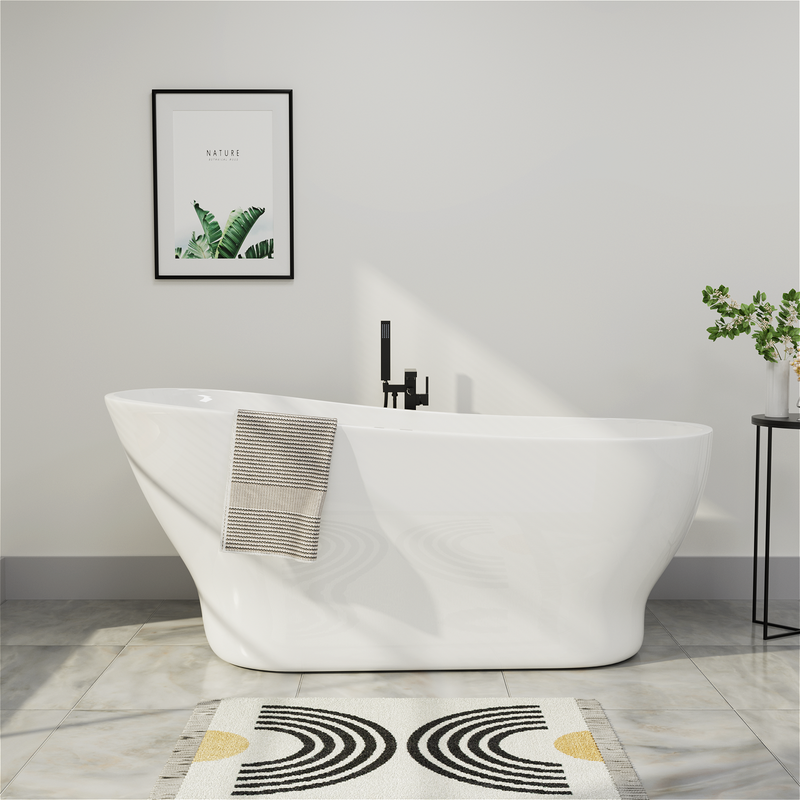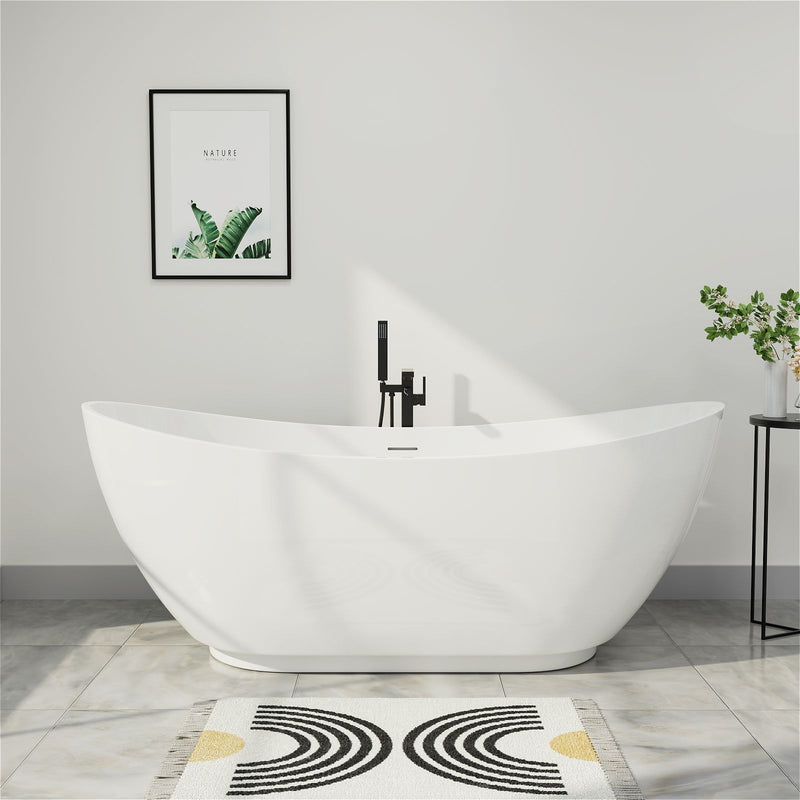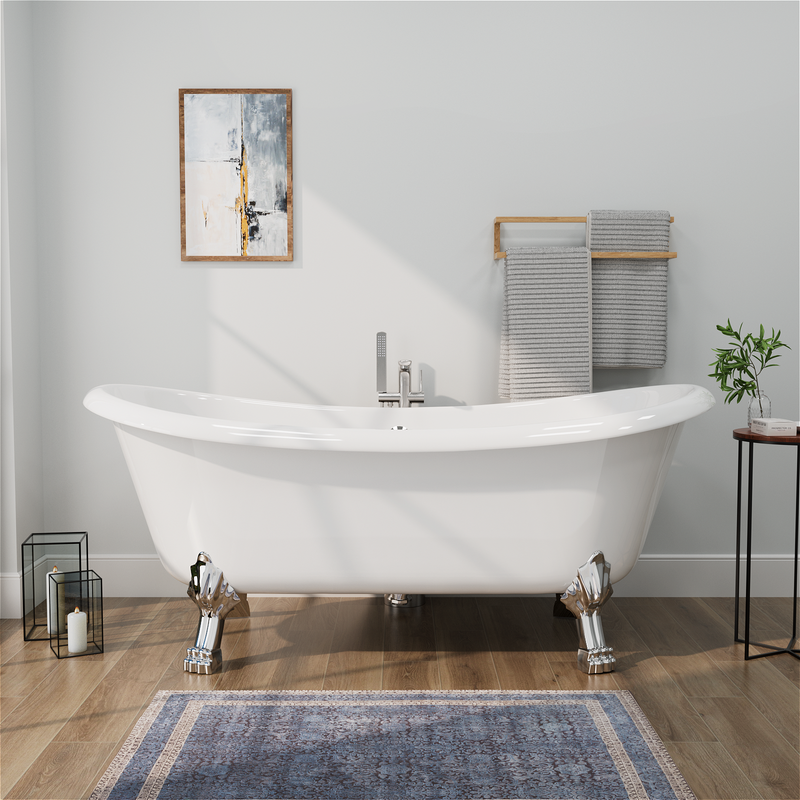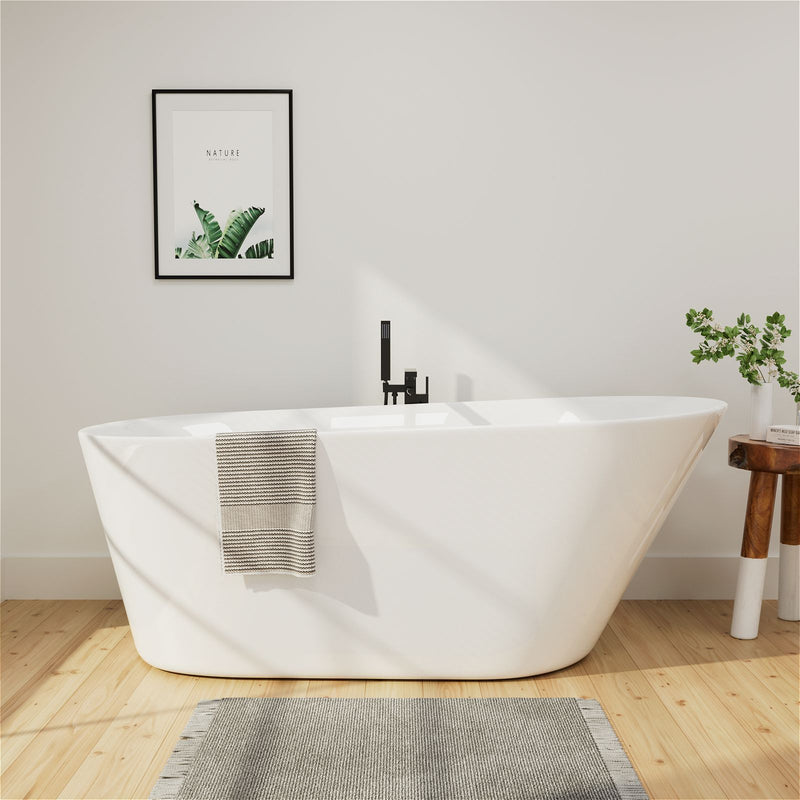After a tiring day at work, you turn on the shower, anticipating a refreshing hot bath, only to find water quickly rising above your ankles and even approaching your feet. The water flow slows and eventually stagnates, leaving you with a slippery floor and a sense of frustration - the classic frustration of a clogged shower drain. In the US, due to factors such as building structure, water quality, and user habits, clogged shower drains are one of the most common plumbing problems in homes, far exceeding kitchen sink clogs. Not only does it ruin a relaxing bath, but long-term water accumulation can breed bacteria, create odors, and even leak into the ceiling below, leading to costly repairs and neighborhood disputes.
The cause of a clogged shower drain may seem simple (simply hair or soap scum buildup), but it hides complex factors such as pipe design, routine maintenance, and even the age of the house. Blindly pouring in highly corrosive unclogging agents or using brute force to pry and unplug often only treats the symptoms rather than the root cause and may even damage fragile PVC pipes or old metal fittings. Understanding the causes of clogs, mastering scientific and effective unclogging methods, and establishing preventative habits are key to ending shower pools. This article systematically analyzes the common causes of shower drain clogs in US homes and provides a comprehensive guide to solutions, from DIY fixes to professional repairs.
Causes of Shower Tray Clogs
Identifying the true cause of a clog is the first step in choosing the right solution. Unlike kitchen sinks, shower drains are primarily vulnerable not to grease or food debris, but to specific substances generated during bathing.

Hair
The Nature of the Problem: Whether long or short, even body hair, it is inevitable that hair will fall out during showering and be carried down the drain by the water. These hairs are non-dissolving and easily become entangled in any protrusions or bends in the drainpipe (especially traps and P-traps).
Accumulation Effect: The amount of hair shed in a single shower is limited, but over time, it accumulates like a snowball, attracting subsequent soap scum, sebum, dust, and even tiny soap flakes, forming a dense mass of hair. This is the most common cause of noticeable drainage slowdowns and even complete blockages.
Risk Points: Hair clumps near floor drains are relatively easy to clean, but if they are swept deeper into the main pipe or become lodged deep in the trap, they become much more difficult to remove.
Soap Scum and Bath Product Residue
Soap Scum Formation: Soap (especially traditional bar soap) combines with minerals in hard water (primarily calcium and magnesium) to form a sticky, insoluble deposit commonly known as soap scum. This scum acts like glue, adhering to pipe walls and hair clumps.
Shower Gel and Conditioner: Although liquid products tend to produce less soap scum, they contain ingredients like grease, silicone oil, and thickeners. These ingredients easily form a sticky film on pipe walls, which not only slowly accumulates but also acts as a barrier and speed bump for debris like hair and dandruff.
Consequences: Soap scum and bath product residue can significantly increase the volume and viscosity of clogs, making them more stubborn and accelerating the formation of clogs.
Mineral Deposits (Scale)
Hard Water Problems: Tap water in many parts of the United States (especially the Midwest and Southwest) is hard, containing high concentrations of minerals such as calcium and magnesium. When hot water flows through pipes, these minerals tend to precipitate and deposit on the pipe walls.
Deposition Process: Over time, this layer of mineral deposits (scale) gradually thickens, like stalactites in pipes, reducing the pipe's internal diameter. Even in the absence of hair and soap scum, severe scale deposits can cause poor water flow and even blockages.
Exacerbating Clogs: The rough surface of scale is more susceptible to catching hair and soap scum, making common blockages more severe and difficult to completely remove in hard water areas.
Improperly Discarded Items
Small items: Shampoo bottle caps, small accessories, razor blades, children's toy parts, etc. accidentally dropped into drains.
Misleading Flushable Products: Some products advertised as flushable, such as wipes, cotton swabs, tampons, cotton pads, and contact lenses, are not readily disintegratable and can easily get stuck in pipe bends, causing serious blockages.
Construction Residue: After renovations or repairs, cement debris, putty, plastic packaging, and even tool parts may remain in pipes.
Characteristics: These blockages often occur suddenly, completely interrupting drainage. DIY methods are often ineffective, requiring specialized tools to remove them.
Pipe Structural Problems and Aging
P-Trap Design: To prevent sewer gas odors, all drain pipes must have a trap (U-shaped or P-shaped pipe). While necessary, this design also creates a natural trap for debris to accumulate, making it a high-risk area for blockages.
Insufficient Pipe Slope: Drain pipes require a certain inclination (grade) to ensure smooth flow of sewage to the main line. If the slope is insufficient during installation or changes due to subsequent building settlement, water flow is slowed, making it easier for impurities to settle and cause blockages.
Aging and Damaged Pipes: Older homes may use cast iron or galvanized steel pipes. The inner walls of these metal pipes are prone to rust and corrosion, resulting in a rough surface and rust nodules. This not only reduces the pipe diameter but also makes it more likely for debris to become trapped. Although PVC pipes are corrosion-resistant, loose joints, tree root intrusion (main pipes), or physical damage can lead to poor flow or blockage.
Main Pipe Problems: Shower drains ultimately flow into the house's main sewer. If the main pipe itself is clogged (due to tree roots, grease, large debris accumulation, or collapse), it can affect all downstream drainage points, including the shower tray. In this case, blockage symptoms may occur simultaneously at multiple drain outlets (such as the toilet and sink).

DIY Self-Rescue Guide: Safe and Effective Home Unclogging Methods
When faced with a clogged shower tray, there's no need to call an expensive plumber immediately. Many early or moderate blockages can be resolved with the following safe and effective DIY methods. Always exercise caution and prioritize methods that minimize damage to the pipe.
Physical Removal (Safest and First Choice)
Clean the Drain Cover with Your Hands or Tools
Turn off the water and put on rubber gloves.
Try to clean the hair and visible debris covering the shower drain cover (strainer) by hand or with an old toothbrush or a small hook. This is the simplest, most often overlooked, and often has an immediate effect.
Many modern drain covers are designed to twist or click open, allowing easy access to the primary filter/hair collection basket underneath. Making it a habit to clean this area regularly (e.g., weekly) is key to preventing clogs.
Pump Plunger Power
Useful for: Often effective for clogged drain traps (caused by hair, soap scum, and clumps).
Key Points:
Ensure there is enough water in the shower tray to cover the rubber bowl edge of the plunger (approximately 5-10 cm deep) to create a seal.
Press the plunger down firmly to squeeze out the air, then quickly pull it upward. Repeat several times to create a strong suction and pressure action.
Focus on creating a quick impact, not a slow push. After a few attempts, quickly pull the plunger upward to see if the accumulated water drains quickly.
Note: Using a shower tray plunger designed for flat bottoms (with a larger cup and a flat bottom) is much more effective than a standard toilet plunger (with a ridged bottom). Ensure the rubber bowl makes good contact with the bottom of the tray to create a good seal.
Drain Snake/Auger
Useful when: When a plunger is ineffective and the clog is located deeper below the drain (such as in a trap or further down the pipe), this is the most effective DIY tool.
Type Selection:
Manual Spring-loaded Drain Snakes: Typically about 5-10 meters long, with a small hook or spiral tip at the end. By cranking the handle, the spring snake is threaded into the pipe, hooking out or breaking up clogs (primarily hair clumps). Suitable for clogs close to the drain, with well-defined curves, such as shower trays.
Electric Drain Snakes: More powerful and suitable for more stubborn or deeper clogs, but more complex and skilled operation, making them more suitable for more severe clogs or experienced DIYers.
Instructions (For Manual Snakes):
Remove the drain cover.
Carefully insert the tip of the drain snake into the drain opening, slowly pushing inward while turning the handle clockwise.
When you feel resistance, the clog may be at the point of the clog. Continue rotating and gently pushing and pulling to try to hook or loosen the clog.
If you encounter a noticeable blockage (such as a trap), patiently twist and turn the rod back and forth repeatedly to maneuver it around the bend.
Once you feel the rod has passed smoothly, slowly pull it out, which will usually remove a large amount of hair and dirt. Clean the rod.
Flush the pipe with plenty of hot water to check whether drainage is restored.
CAUTION: Be gentle and avoid forcing through PVC pipe joints or scratching the pipe's interior. Wear gloves, as the dirt may be quite dirty.
Chemical Drain Cleaner
How It Works
A strong base (such as sodium hydroxide/caustic soda) or a strong acid dissolves organic matter (hair, soap scum) or corrodes mineral deposits. It works quickly but carries a high risk.
High Risk Warning
Extremely Corrosive: Risk of severe burns to skin and eyes. Wear goggles, rubber gloves, and long-sleeved clothing when handling, and maintain adequate ventilation.
Pipe Killer: Severely corrodes old metal pipes (cast iron, galvanized), accelerating their deterioration and leakage. Even PVC pipes can become brittle and deteriorate with frequent or excessive use. Never use on completely blocked pipes! Liquid cannot flow to the blockage and will remain in the upper pipe for a long time, increasing the risk of corrosion.
Environmental Issues: Toxic and harmful, improper handling can pollute the environment.
Limited Effectiveness: Ineffective against solid foreign objects (small toys), severe mineral deposits, or structural problems. Slow and incomplete dissolution of dense clumps of hair.
If You Must Use It
Follow the Instructions Carefully: Carefully read and strictly adhere to the dosage, duration of action, and safety warnings. Never mix different brands or types of clog removers (highly toxic fumes may be produced).
Start with the Smallest Dose: Gel-based products are preferred, as they adhere better and last longer on the clog.
Flush Thoroughly: After the duration of action is complete, flush the pipe thoroughly with plenty of cold water (not hot water! It may cause a violent reaction) for at least 5 minutes.
Alternative Options
For light maintenance or light grease and soap scum, try a gentler enzymatic cleaner. These use bacterial enzymes to break down organic matter. While slow-acting (taking several hours to overnight), they are safe, environmentally friendly, and suitable for regular preventative maintenance.
Physical Cleaning Upgrade: Disassembling the Trap (For Pipes With Access Ports)
Suitable Situations
If there is an accessible pipe access port (cleanout) under the shower tray, or you have safe access to the trap (usually located in the downstairs ceiling or basement), this is the most direct way to clear a clogged trap.
Key Points
Preparation: Place a large bucket or basin under the access port or trap to collect dirty water. Wear full protective gear (gloves, goggles, old clothing).
Disassembly: Using a pipe wrench or wrench, carefully unscrew the access port cap or the trap's connecting nut (usually a slip nut). Be aware that a large amount of dirty water may gush out.
Cleaning: Remove the clog (usually a nasty mass of hair and soap scum) from the trap directly with your hands or a tool. Thoroughly clean the inside of the elbow.
Restoration: Carefully reassemble the disassembled parts, ensuring the washer is properly seated and intact. Tighten the nuts, but avoid excessive force that may cause cracking.
Testing: Turn on the faucet to test for leaks and ensure the drain is clear.
Advantages
Thorough inspection allows for immediate identification of any problems.
Disadvantages
Requires manual dexterity and tools, can be contaminated by dirty water, and may require limited access. If the pipe is old, disassembly may damage it or make it difficult to restore the seal.

When Should You Call a Professional Plumber?
Recognizing the limitations of DIY plumbing is crucial. If a minor problem turns into a major disaster, contact a licensed professional plumber immediately:
All DIY Methods Have Failed: After using plungers, unclogging strips, and even (cautiously) chemical methods, the drain remains blocked or completely clogged.
Recurring Blockage: A blockage that recurs shortly after unclogging indicates the underlying cause of the blockage (such as deep-seated buildup, structural issues, or main pipe problems) has not been addressed.
Multiple Drainage Issues: Not only is the shower pan clogged, but the toilet also struggles to flush, the sink drains slowly, and even the basement drain is backing up. This strongly suggests a blockage or damage to the main sewer line.
Suspected Foreign Objects or Structural Damage: An object has been dropped and cannot be removed, or a hard object (such as a toy or tool part) feels snagged while unclogging. Suspected pipe cracks, collapses, tree roots, or severe corrosion.
Signs of a Leaky Pipe: During attempts to unclog a pipe or during daily use, you may notice water stains, dripping, mold, or bubbling under the shower tray, on adjacent walls, or on the ceiling below. This indicates that the pipe may have been damaged by the pressure of a blockage, corrosion, or improper unclogging procedures and requires immediate attention.
Old Plumbing Systems: The house uses older materials such as cast iron, galvanized steel, or clay pipes, and the condition of the pipes is unknown, making DIY unclogging too risky.
Lack of Tools, Skills, or Confidence: Removing traps or using an electric unclogging machine is difficult or dangerous.
Advantages of a Professional Plumber
Professional Tools: They possess powerful electric dredging machines (capable of reaching deep into main pipes), borescopes (for precisely identifying the location and nature of blockages), and high-pressure water jets (for effectively removing stubborn grease, tree roots, and sediment from pipe walls without damaging the pipe walls).
Experience: They can quickly and accurately determine the cause and location of blockages and select the optimal solution.
Handling Complex Problems: They can safely handle major projects such as main pipe blockages, pipe repairs, or replacements.
Warranty and Liability: Reputable plumbers offer a warranty on their services and parts, and carry insurance for their work, reducing risk for owners.
Good Habits for Preventing Clogs
Instead of spending time, effort, and money on unclogging clogs, establish daily preventative habits to nip the problem in the bud:
Drain Covers
Must-have and Effective: Always install and use a shower drain cover (drain cover/strainer). Choose one with a fine mesh that effectively traps hair.
Frequent Cleaning: Make it a habit to clean the drain cover after every shower, or at least every day, to remove accumulated hair and soap scum. This is the simplest, cheapest, and most effective preventative measure! Remove the drain cover weekly to clean any hair that may be trapped underneath.
Flush Regularly with Hot Water
Once or twice a week, after showering, flush the drain with full, hot water (make sure it's a safe temperature) for 1-2 minutes. The hot water helps dissolve and remove any early buildup of soap, grease and some soap scum.
Mild Cleanser Maintenance
Baking Soda + White Vinegar: Once or twice a month, pour half a cup of baking soda down the drain, followed by half a cup of white vinegar. The reaction will produce foam. Let it sit for 15-30 minutes, then rinse with plenty of hot water. This method helps break down light grease, soap scum, and odors, and is safe and environmentally friendly.
Enzyme-Based Bio-Cleaner: Use once a month or according to the product instructions. Pour the prescribed amount, add a small amount of warm water to activate, let it sit overnight (do not use water), and rinse with hot water the next day. This method uses beneficial bacteria to break down organic matter and is suitable for daily maintenance.
Choose Bath Products Wisely
Avoid Heavy, Greasy Formulas: Opt for easy-to-rinse, low-residue body washes and shampoos. Avoid products that claim to be extremely moisturizing or contain large amounts of shea or cocoa butter, which can leave heavy residue.
Use Bath Oils and Hair Masks with Caution: If used, use minimal amounts and ensure they are thoroughly rinsed with plenty of hot water.
Keep Flushable Products out of Pipes: Never throw wipes, cotton swabs, tampons, cotton pads, hair (even a small wad), food scraps, or anything else other than toilet paper, fecal matter, or water down the shower drain or toilet!
Preventing Scale in Hard Water Areas
Home Water Softener: If your local water is very hard, considering installing a whole-house water softener is the most fundamental solution. It can significantly reduce scale deposits on pipes, fixtures, and faucets, extending the life of your equipment.
Regular Descaling: Even if you have a water softener, you can regularly (e.g., quarterly) use a dedicated pipe descaling agent (choose a mild acid, such as citric acid, and use according to the instructions), or increase the frequency of cleaning with baking soda and white vinegar.
Conclusion: Enjoy a Smooth, Refreshing Shower Every Time
Clogged shower drains, while a common problem in countless American households, are by no means insurmountable. Understanding the mechanisms behind the five main culprits - hair, soap scum, scale, foreign matter, and aging pipes - is the foundation for successful problem resolution. When faced with a blockage, remain calm and follow a step-by-step approach: prioritize physical removal (using hand cleaning, plungers, or unclogging strips), cautiously use chemical unclogging, and promptly seek professional assistance. This will effectively resolve the problem while maximizing pipe safety and personal health.
However, true wisdom lies in prevention. Make cleaning your drain cover a daily habit, like brushing your teeth. Regularly flush the drain with hot water or a mild detergent. Choose wisely the right cleaning products. And resolutely prevent foreign matter from entering the drain. These simple yet consistent preventative measures are far more valuable than any single unclogging. They act as an invisible barrier to health for your shower system, ensuring unimpeded water flow and transforming the anticipation of every shower into pure relaxation and refreshment. Remember, a clear drain is not only about water flow but also about the convenience, hygiene, and tranquility of home life.

